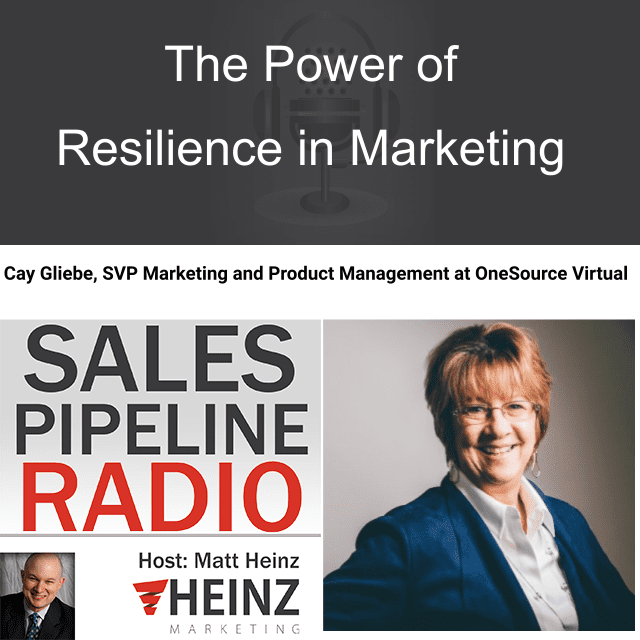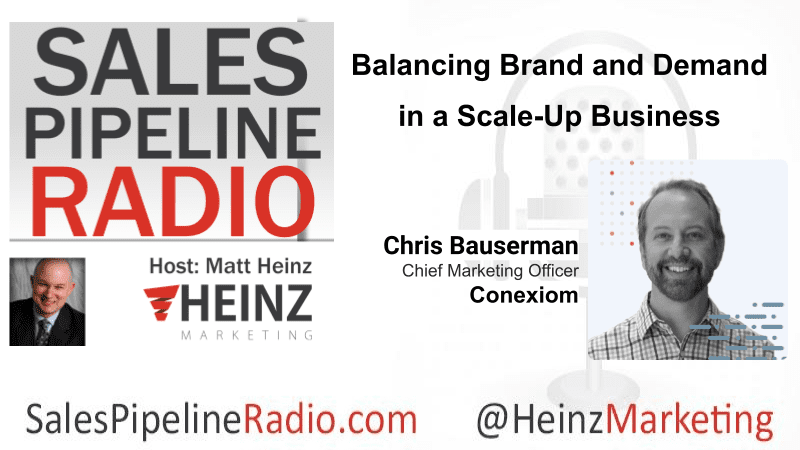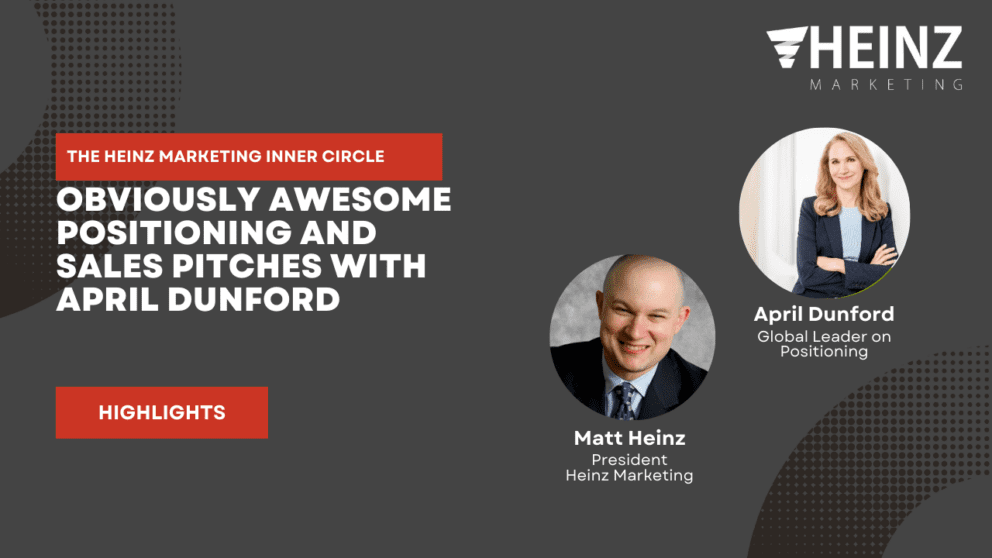Sales Pipeline Radio, Episode 249: Q & A with Cay Gliebe @CayGliebe1

By Matt Heinz, President of Heinz Marketing
If you’re not already subscribed to Sales Pipeline Radio, or listening live every Thursday at 11:30 a.m Pacific on LinkedIn (also on demand) you can find the transcription and recording here on the blog every Monday morning. The show is less than 30 minutes, fast-paced and full of actionable advice, best practices and more for B2B sales & marketing professionals.
We cover a wide range of topics, with a focus on sales development and inside sales priorities. You can subscribe right at Sales Pipeline Radio and/or listen to full recordings of past shows everywhere you listen to podcasts! Spotify, iTunes, Blubrry, Google Play, iHeartRADIO, Stitcher and now on Amazon music. You can even ask Alexa!
This week’s show is called “The Power of Resilience in Marketing” and our guest is Cay Gliebe, SVP Marketing and Product Management for OneSource Virtual
Cay gives us some great insight as she and Matt discuss some of the benefits of sales and marketing alignment, addressing the baggage brought to the table by both marketing and sales, some best practices to create more natural alignment, and making products a part of sales and marketing alignment.
Listen in now and/or read the full transcript below.
Matt Heinz: All right, boys and girls, welcome to another episode of Sales Pipeline Radio. So thankful you’re all joining us today. If you’re watching us live on LinkedIn, thank you very much for joining us in the middle of your work day beginning of June, almost halfway through the year. At least it’s summer now, early mornings, late evenings, lingering outside, dining outside. It’s all good. But we are here every week as some of you know, every week, 11:30 Pacific, 2:30 Eastern. Now doing this on LinkedIn live in addition to our podcast. So you can join us live at any time. If you’re watching this on demand, thank you very much for checking it out. If you are subscribed or listening through the podcast through the audio only version, thank you so much for continuing to listen and download.
If you like what you hear today, this is what we do almost every week and we have almost 300 episodes available on demand at salespipelineradio.com. Every week we’re featuring some of the best and brightest minds in B2B sales and marketing. Today is no different. Very excited to have someone I consider a friend. She is the SVP of marketing and product management a One Source Virtual, Cay Gliebe. Cay, thank you so much for joining us today.
Cay Gliebe: My pleasure, Matt. I’m so happy to be one of your guests.
Matt Heinz: Oh my goodness. There are so many things we could talk about. You are a regular at our Friday morning CMO Coffee Talk group as well, and every time you share something the chat lights up with people saying, “I want to be Cay when I grow up,” just because you’ve got good instincts and experience and together it’s really, really useful. When we talked about what to cover today, because we can literally cover anything. You immediately narrowed in on one of my favorite topics, which is sales and marketing alignment, which look, it’s one thing to say sales kickoff, sales and marketing agree on things, it’s another thing to put that in practice. So I guess maybe I’ll start with, of all the topics we could cover, it’s the first one you mentioned. Why? Why is that one at the top of your mind?
Cay Gliebe: It is the one thing that gets the most visibility at the C level really, is sales and marketing joined at the hip. Do they have agreement and alignment on what they’re going out to do? And do they trust each other or do they throw each other under the bus to make sure that all the numbers that are being reported, all of the success is done jointly, and I frequently say to one of our sales RVPs, I care more that his team is getting all of the opportunities we can possibly provide. It doesn’t matter if we hit the target. I want us to do as many as we can so that his team can do what they do best and that’s closing win deals. And that’s the level of trust you want to be able to have between the two groups.
Matt Heinz: We cover this topic a lot in conversations, in client engagements, and sometimes I’ll say, why isn’t there better alignment? I mean, as a lifelong marketer, I now have a sales role running my own business, but as a lifelong marketer, I feel pretty comfortable saying this is our fault. Marketers in general have not operated as revenue responsible teams in the past. So I think both sides often bring a lot of baggage to the table. Clearly what happened in the past doesn’t matter to the future, but talk a little bit about that baggage and the precedent of how sales and marketing teams work together and how you do, I think sometimes have to address that, have an amnesty day or something that allows you to say, “Here’s how I’ve always perceived the other side. Now we can move forward.”
Cay Gliebe: I’m going to pick on a couple of things that you said in there. I do think it’s the marketer’s fault to start with, and it starts with the marketer and it is because the marketer doesn’t want to sign up for the number. I’ve been in many different functions in organizations, so unlike you, who have been in marketing forever, I like to say I dabbled in a lot of different roles within an organization. But the one thing that I know is that as a marketer, if your team doesn’t believe that, that revenue number or that customer retention number are as important and your commitment too, you’re not going to get alignment, you are not going to be doing the things that align the company successfully. Companies don’t need marketing to just do great things and put out cool ads and say, “Well, we’re influencing so many opportunities.” They need to be driving marketing generated opportunities. They need to be showing how they’re getting engagement from that targeted audience, and then getting that passed over to sales in a way that will help them win and to ideally do it at a higher rate because it’s a more qualified opportunity coming in.
Matt Heinz: You touch on expectations around this, and so it’s like, again, it’s one thing we can say at sales kickoff we’re all aligned, how we operationalize, that is a different thing. Some companies talk about having service level agreements. SLA is just sort of saying, “Hey, we’re only going to get these certain type of leads from marketing, and we’re going to promise we’re going to do this kind of follow-up.” I’ve always felt like SLAs are sort of a forced way of driving alignment. What do you consider some of best practices to create more natural alignment and really expectations about how each side is going to operate to support one another?
Cay Gliebe: I would say that people from Missouri, they’re the show me state. I think sales is from the show me state. You put SLAs and all that, you can do that. But what you really need to do is say, “This is the target. This is what we’re going to try to do.” And then you need to show how you’re going to do it. And you have to be willing to get feedback on why it’s working or not working. You also have to be willing to say that sales maybe needs to step up and do their part. They may not be doing all of the things that will help them really take advantage of what marketing is providing, and so accountability becomes a two way street. Another tactic that has worked really well in all of my career is sometimes you just have to find that advocate or that person that you can partner with and show them and help them get success and then others start to follow.
So I’m going to go back to when we started having corporate sales development, Mike Porch, our SVP of sales and I both agreed it was important to have a sales development type role. And we talked about, should it be in sales? Should it be in marketing? We put it in marketing and we have driven tremendous results for getting opportunities to Mike’s team of account executives. In the early years of doing this, we’re about two and a half years into it, almost three years now. But in the early years, we only had a few AEs, account executives who would work with the customer sales development or the corporate sales development representative. And then as it went into the next year and the next year, now everybody is demanding I must have my CSD. And the CSD is really that funnel for everything we’re doing in marketing, all of the things that should be inbound, all the things that should be outbound, and qualifying them and sorting them out so that sales can go faster.
So we’ve taken the role to a different level because many organizations will try a BDR and SDR. We call them CSDs, and we’ve taken it that step level where the CSD actually qualifies the opportunity and says, “We have budget. We have timing. We’re talking to the right decision maker,” all those things so that sales knows they’re going to be brought into to engage with something that makes sense and we have a higher likelihood of converting those. And we’re really excited about the way that we have been able to leverage the CSDs to help get that credibility with the sales department. And we have increased our goals and targets in supporting sales year on year and we’re going to continue to do so.
Matt Heinz: That is such a great story. If you’re just joining us, we’re talking today with Cay Gliebe. She’s the SVP of marketing and product management for One Source Virtual. Speaking of that title, Cay, so we’re talking about alignment between sales and marketing today. How important is it to add product to that alignment mix? Because I think a lot of companies will say, “Well, let’s talk about funnel. Let’s talk about leads. Let’s talk about pass along further into the buying process.” How important is it to make sure there’s alignment between sales, marketing and product, and what does that produce for companies to do it?
Cay Gliebe: I actually need to inject a correction. So we recently decided to break out the product management role and hire an SVP of product management. It’s a big role. It has a lot of accountabilities to it in the alignment. You’re absolutely right. So even though I had that as part of my role, a couple of months ago we hired a new SVP of product management. He’s terrific, [inaudible 00:10:02]. And the connection though has to be that not only are we looking at what products are coming down the pipe and how will marketing think about promoting them and driving campaigns around them. But what about the existing products? What products are important to the company? What are the things that are our bread and butter? What are the products that have the highest profit margin? Where do we have more targeted accounts that we can get more volume if we but focused on it and those business metrics of profitability, scalability, all of those things, you’re looking at those. So being able to talk, and it’s not just sales and product, it’s finance as well.
So a good marketer is going to be thinking about how all of those pieces fit into the type of product mix and the campaigns that we are driving to put in the hands of sales.
Matt Heinz: We hear a lot of talk about sales enablement as a function across sales and marketing today. I’ve heard some people describe it as buyer enablement, which is at least a nice way of saying, “Well, we should really focus on what the buyer wants, not just what we as salespeople want.” I’ve heard some people describe it as revenue enablement, which implies not just the buying process, but the overall, how do you enable the lifetime value across account management and customer service teams as well? When we’re talking about alignment, if you talk about the product side, which I think I liked your perspective on that, but how do we now get the customer side aligned here as well? And how important is that? Or some people say it’s a distraction. It’s a distraction for the team that’s trying to drive net new business. What’s your perspective there?
Cay Gliebe: I think it can be a distraction. First of all, your existing customers are incredibly valuable. To replace any one customer and still have to grow your revenue, well, that’s a hard thing. Why would you willingly let a customer go or not do everything you can to try and keep that? So this year we added a second target and a small group that is focused on customer retention. We’re looking at building customer community. We’re looking at how are we in fact making sure that from a marketing perspective, we’re thinking about the journey of that customer. How are they experiencing us as a brand? Because they fit into brand. Your brand is what the analysts think, what the market thinks, and what your customers say. And if you don’t pull those three things together and make sure that you can build that story around brand, it’s really hard to build because you will kill a deal if you can’t provide a referenceable customer.
If you can’t provide three companies that will say what is good and maybe what is challenging about you, but why that didn’t matter, then you’re just going to have a tough time. Marketing has to care about that. It influences everything we’re trying to do from building brand to upselling the existing customer base and getting a better penetration of products overall.
Matt Heinz: I love it. What we started with talking about today, sales and marketing alignment really has expanded into maybe of a matrixed approach where you’ve got multiple stages of a customer relationship, and then you’ve got multiple departments in the organization, they need to care about this, including organizations that don’t really have any direct touch, maybe with the customer. You bring up finance, for example, even accounting, like the invoices people see. I’ve seen a couple of CMOs at large organizations complained that their company’s name was spelled wrong on an invoice. That’s something coming out of an accounts receivable organization that may not touch the customer, but all of a sudden it’s a touch point. It’s an impression of your brand. Even if it’s just optics, even if you can say, “Oh, well, it’s just because…” No, no, no, no, no. This is what your customer sees.
Cay Gliebe: Right, right. And take it even to customer communications. So when you have a heavy operations focus for your products or your services or whatever, if every department is sending out something differently every week and it’s going to pretty much the same people, they’re going to stop paying attention. They’re not going to read what you’re sending out. If it’s poorly written, it’s going to be a ding against what your brand is trying to represent in professionalism. So all of those pieces do roll up for us into marketing, and we are working with customer success operations, finance to understand profitability, viability, where are we at plan? What are the targets for this year? What are the targets for net new? So it’s not just about sales net new accounts, it’s also about what are we upselling? What are we doing to keep that funnel moving and producing?
Matt Heinz: Love it. Well, we’re just a couple more minutes left with our guest today. Cay Gliebe talking about sales and marketing alignment, really overall sort of revenue alignment. This is no longer a binary thing. This is a matrix. You got me thinking about a whole new framework for how to think about this. Ultimately, if you’re listening to this and thinking, “Boy, I’m just having a hard time getting these two organizations to have the same goal.” This matrix approach I think is really, really powerful, but could be intimidating for people that aren’t there yet. Let’s say next week you start as CMO at a new company, let’s say someone listening either is doing the same or says, “You know what? I want to enact this kind of change and this kind of impact on my organization.” Where do people start? Where are some of the foundational elements that can make this successful?
Cay Gliebe: Get to know the people leading the group. Get to know the people right below them and find out what’s important to them. What are they tracking? What are they measuring? What do they perceive the problems are? What do they think about the marketing department? What do they think about the relationship between sales and marketing? Because that’s the easy thing to pick. What’s harder to point out, is marketing thinking about the financials? Is marketing thinking about customer success? Does marketing have an eye to how operations is performing and what that could potentially do to enhance or detract from the brand? So the very first thing is you have to know those people and you have to find a way to connect with them and figure out what you can do for them. Not what they can do for you, what you can do for them, because it’s important to them.
Matt Heinz: Well, that’s a great point to end on. What can you do for them? Put that perspective forward first and foremost. Cay, you do not disappoint. I think I mentioned before we got started, you are a regular for our CMO group on Friday mornings and whenever you have something to share, the chat just lights up. Everyone is like, “I want to be Cay when I grow up.” This is so good, your perspective and just the way you think through it as well. So refreshing and helpful. So thank you so much, everyone for listening. Thank you to Cay Gliebe, our guest today, the SVP of marketing at One Source Virtual. We will have this episode on demand if you want to share this with other people on your team, other people in your network. We’ll have this on demand almost immediately on LinkedIn. And we’ll have this up on salespipelineradio.com as well. Thank you very much for watching and listening. We’ll be here again next week, 11:30 Pacific, 2:30 Eastern. Until then, this is Matt Heinz. Thanks for watching another episode of Sales Pipeline Radio.

I interview the best and brightest minds in sales and Marketing. If you would like to be a guest on Sales Pipeline Radio send an email to Sheena. For sponsorship opportunities, contact Cherie.





